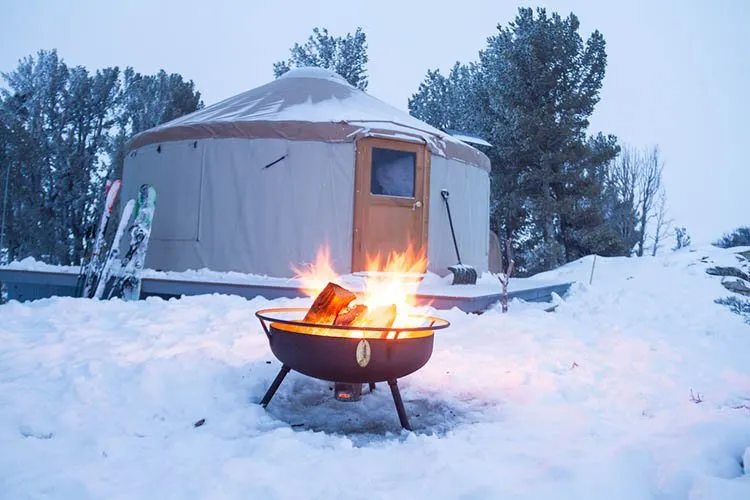Yurts are gaining in popularity as a relatively easy and affordable housing alternative to the costly reality of a traditional home. Yurts have been increasingly used as a primary dwelling, to add living space on existing land, or as a way to generate rental income on a property. They are also built for specific purposes such as an artist studio, an office, a yoga studio, or a meditation spot.
What is a Yurt?
The yurt is an ancient structure that was once used by nomad peoples in Central Asia. This tent-like structure is a bit stronger and more permanent than a typical tent. They are generally considered semi-permanent, as they are usually built on a wooden platform but can be moved to another location. Yurts are low maintenance, and they can be customized and outfitted with many of the modern amenities that we have become accustomed to.
Yurts are a good option if you are looking for an environmentally-conscious and budget-friendly living option. Yurts require fewer building materials and take up a smaller footprint than a traditional home. Their circular structure can be scaled small or large to fit your requirements. While a traditional yurt is usually an open plan layout, modern yurts have added interior walls, kitchens, bathrooms to the floor plan.
While the yurt is a relatively simple structure, it can be customized to provide a modern lifestyle that still brings you close to nature and provides a simple way of life but with modern conveniences like electricity and plumbing.
View this post on Instagram
Can You Add Plumbing to a Yurt?
The first yurts were built before electricity and running water, but modern yurts certainly can have electricity and plumbing added to them.
If you are looking to add plumbing to a yurt, the most common option is to dig a well and pump your water up from the ground. If a well is not possible on the land where your yurt is located or if it’s out of budget, another option is to collect water from a nearby source.
The main factor when it comes to determining if a yurt can be hooked up to water is where the yurt is located. Obviously, if you are in an area where there is already a septic tank or where there are municipal water hookups, it is going to be far easier to install water without having to do a ton of extra work like digging a well.
If you are building your yurt in an area where there is not a hookup or a septic tank already present, you do need to check with the planning and zoning board where you are building and then have a septic tank added or have the yurt hooked up to a municipal sewer system.
Hiring a professional plumber is going to be your best bet to get plumbing installed for your yurt. To add running water to your yurt, you might need to build the yurt on a platform. Building on a platform allows a place to put your plumbing. The plumbing can be placed under the platform that is going to raise your yurt up off of the ground, they can be very high up off the ground, or just high enough to house your plumbing.
When you place your platform, your plumber can then work to place the plumbing and run it up through the floor to your toilet, your shower, your tub, and sinks. This is going to allow you the chance to place plumbing where you want it and where you need it.
View this post on Instagram
When to Add Plumbing to a Yurt?
If you have an existing yurt and you want to add plumbing but not add a platform, you may need to add interior walls that are drywall and more permanent. While traditional yurt structures are open plan, interior walls are becoming more popular additions to create privacy, especially when adding a bathroom, kitchen, or bedroom to the space.
If you want to add a bathroom but don’t want to add interior walls, another option is to build a separate structure on the side of the yurt that is separate but connected.
Adding plumbing is always best when you first start building the yurt or before it is finalized. If you already have the yurt in place, you can add plumbing with the help of a plumber and with some creative options.
Due to the small space in a yurt, it’s a good idea to layout on one wall – sometimes referred to as a “wet wall”. A wet wall containing all your plumbing and your fixtures (kitchen, bath) should be planned so that they are adjacent to this wall.
Plumbing Alternatives
If you want to add a bathroom but dont’ have access to plumbing, another popular option is a compostable toilet. Composting toilets are non-flush toilets that use biological processes to process human waste. Waste is mixed with materials that might include peat moss, wood chips, leaves, or other alternatives to dispose of waste without using much water. With proper maintenance and ventilation, compostable toilets can be odorless and work well.
Other alternatives to plumbing include the use of freshwater tanks. You can also add gray water systems that use the water from showers and from your sinks to help move the waste from the toilet away as well.
Modern conveniences can be added to yurts with proper planning. Today, yurts are being built with modern kitchens and bathrooms once you have installed electricity and plumbing. Adding modern conveniences to a yurt is definitely possible and can add to the enjoyment of living in a yurt for years to come – whether it’s used as a full-time home, a vacation rental, or a guest living space.

